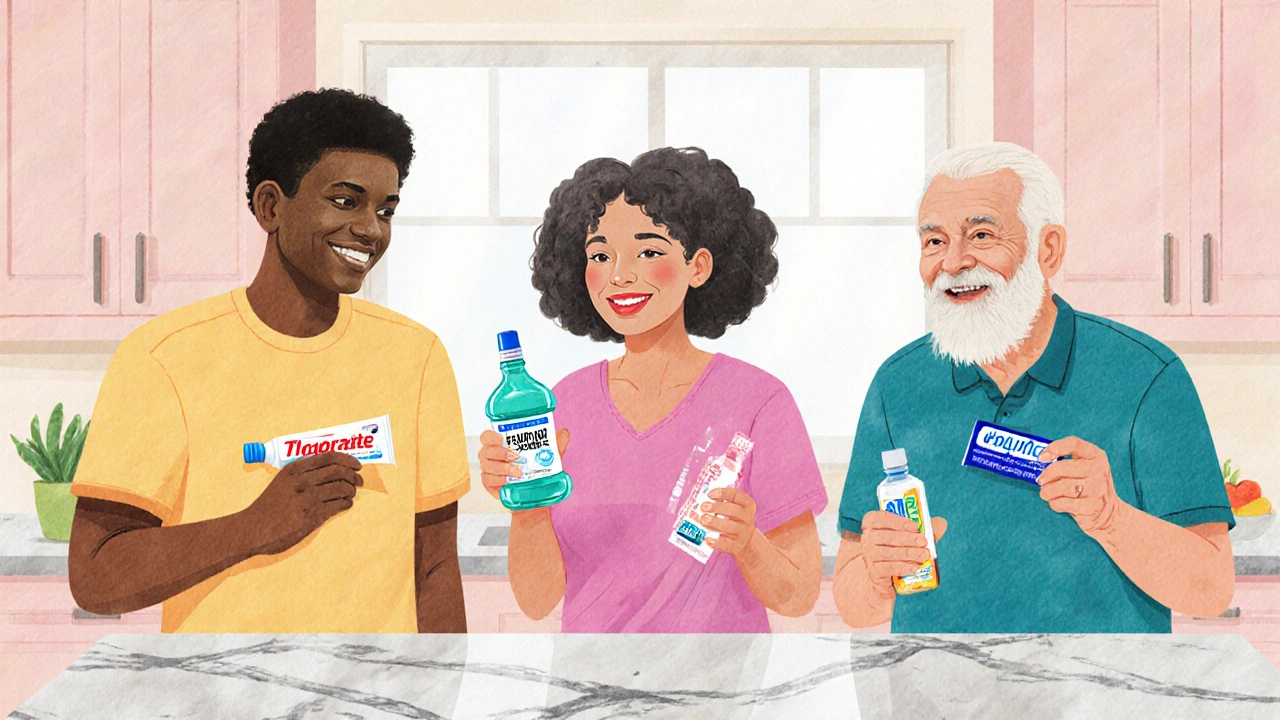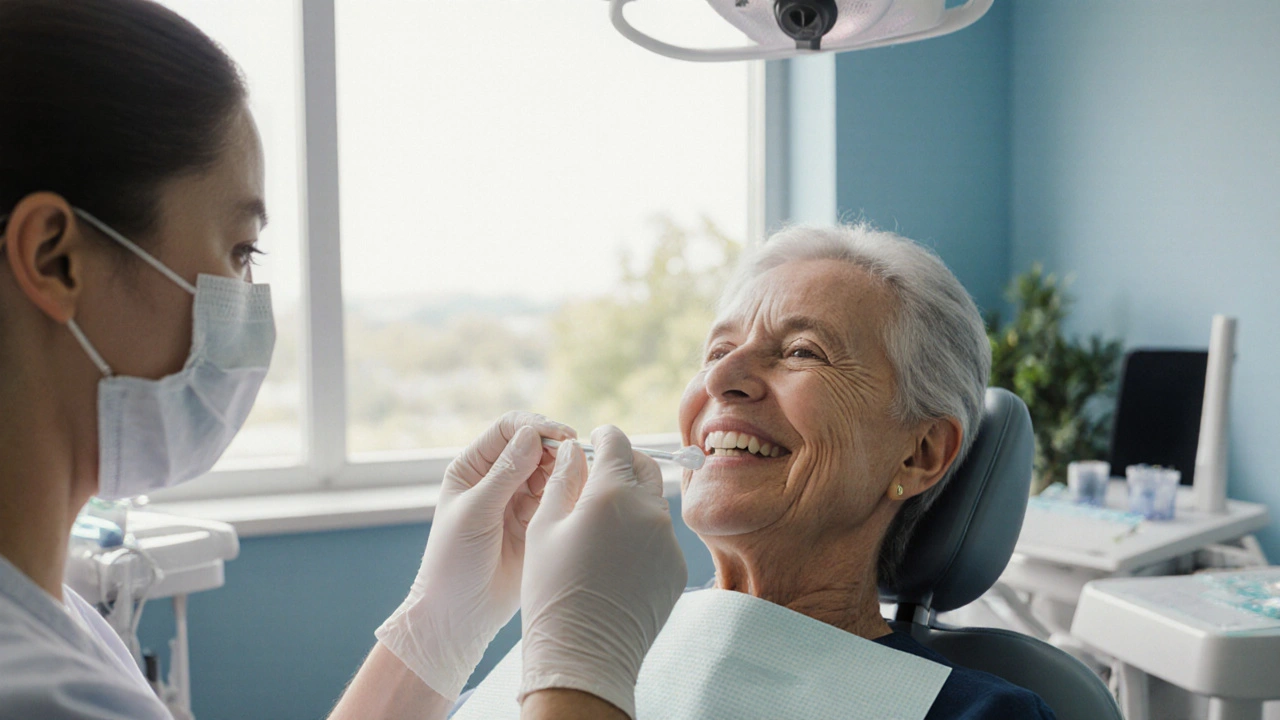Dry Mouth Prophylaxis Planner
This interactive tool helps you determine personalized strategies to manage dry mouth symptoms and prevent complications.
Assess Your Symptoms
5- Prophylaxis cuts the risk of cavities and infection for dry‑mouth sufferers.
- Simple habits like chewing sugar‑free gum boost natural saliva.
- Fluoride varnish and high‑fluoride toothpaste seal teeth against decay.
- Artificial saliva and chlorhexidine rinses keep the mouth moist and bacteria‑free.
- Follow a step‑by‑step plan to stay comfortable and protect your smile.
Living with dry mouth feels like walking around with a desert in your mouth. The lack of saliva makes it hard to swallow, talk, and even smile. The good news? A solid prophylactic routine can turn that desert into a well‑watered garden. Below you’ll find a practical guide that explains why prevention works, what tools are available, and how to build a plan that fits your daily life.
What Is Dry Mouth Syndrome?
Dry Mouth Syndrome is a condition, also called xerostomia, where the salivary glands don’t produce enough fluid to keep the mouth moist. It can be caused by medications, autoimmune disorders like Sjögren’s syndrome, radiation therapy, or simply aging. Without enough saliva, the mouth loses its natural cleaning action, buffering capacity, and antimicrobial proteins, leaving teeth and gums vulnerable.
Why Prophylaxis Matters
Saliva does more than keep your tongue wet. It neutralizes acids, supplies calcium and phosphate for remineralization, and carries enzymes that fight harmful bacteria. When saliva drops, three problems pop up quickly:
- Increased risk of Dental Caries - especially on the smooth surfaces of teeth.
- Higher chance of Oral Candidiasis (thrush) because the mouth’s natural defenses are weakened.
- Persistent discomfort, bad breath, and difficulty speaking or swallowing.
Prophylaxis-preventive care-targets each of those issues before they become serious. It’s not a one‑size‑fits‑all recipe; it’s a toolbox you can customize.
Core Prophylactic Strategies
Below are the main weapons that clinicians recommend for dry mouth prophylaxis. Each one tackles a specific weakness caused by low saliva.
1. Boost Natural Saliva Production
The first line of defense is to stimulate whatever saliva the glands can still make. Sialagogues are agents that trigger saliva flow. Chewing sugar‑free gum, sucking on xylitol lozenges, or using prescription‑strength pilocarpine are common options.
Why sugar‑free? Regular gum can feed bacteria, while sugar‑free gum (often sweetened with sorbitol or xylitol) encourages saliva without feeding decay‑causing microbes.
2. Use Saliva Substitutes
When the glands are too damaged to respond, artificial fluids step in. Saliva Substitutes-over‑the‑counter sprays, gels, and rinses-often contain carboxymethylcellulose or glycerin to coat the mouth. Brands like Biotene are formulated to mimic the lubricating and buffering properties of real saliva.
3. Apply Fluoride Varnish and Use High‑Fluoride Toothpaste
Fluoride is the best shield against cavities. Fluoride Varnish is a paint‑like coating that a dentist applies two to four times a year. It releases fluoride over weeks, hardening enamel in a dry environment where regular brushing alone isn’t enough.
At home, a toothpaste containing 5000ppm fluoride (often sold as “high‑fluoride” or “prescription‑strength”) provides daily reinforcement.
4. Incorporate Antimicrobial Rinses
Because dry mouth encourages bacterial overgrowth, a gentle antimicrobial rinse can keep the ecosystem balanced. Chlorhexidine Rinse (typically 0.12% concentration) is prescribed for short periods to suppress plaque‑forming bacteria without causing the burning sensation that alcohol‑based mouthwashes can.
5. Lifestyle Tweaks
Simple habits make a big difference:
- Sip water regularly-small sips every 15minutes keep the oral tissues hydrated.
- Avoid alcohol, caffeine, and tobacco, all of which dry the mouth further.
- Use a humidifier at night, especially in dry climates or heated rooms.

Comparing Prophylactic Options
| Strategy | Primary Benefit | Typical Cost (USD) | Best For |
|---|---|---|---|
| Sugar‑Free Gum / Xylitol Lozenges | Stimulates residual saliva | $0.05‑$0.15 per piece | Mild‑to‑moderate xerostomia, on‑the‑go |
| Prescription Sialagogues (e.g., Pilocarpine) | Pharmacologic saliva boost | $30‑$80 per month | Severe gland damage, under doctor supervision |
| Artificial Saliva Sprays/Gels | Provides immediate lubrication | $10‑$25 per bottle | Night‑time dryness, post‑radiation patients |
| Fluoride Varnish (in‑office) | Long‑lasting enamel protection | $30‑$60 per application | High caries risk, especially with dry mouth |
| Chlorhexidine Rinse (short‑term) | Reduces bacterial load | $15‑$25 for 2‑week supply | Thrush‑prone patients, after dental procedures |
Step‑by‑Step Plan to Start Your Prophylaxis Routine
- Schedule a dental check‑up. Ask the dentist to assess your salivary flow and recommend a tailored fluoride varnish schedule.
- Pick a daily saliva‑stimulating habit: chew two pieces of sugar‑free gum after each meal or keep xylitol lozenges handy.
- Choose an artificial saliva product you like the taste of. Apply it after meals and before bed.
- Use a high‑fluoride toothpaste twice a day. If you have braces or a high caries risk, ask for a prescription‑strength paste.
- If your dentist suggests it, start a 2‑week course of chlorhexidine rinse-use it once in the morning and once at night, avoiding food or drink for 30minutes afterward.
- Track your symptoms in a simple log (dryness level 1‑10, any pain, frequency of gum chewing). Review this log with your dentist every 3‑4months.
Common Pitfalls and Pro Tips
Even the best plan can flop if you trip over small mistakes. Here’s what to watch out for:
- Skipping hydration. A dry mouth stays dry if you don’t sip water throughout the day.
- Using regular mouthwash. Alcohol‑based rinses wipe away the thin moisture film you’re trying to protect.
- Relying on candy‑flavored saliva substitutes. Sugar substitutes can sometimes feed acid‑producing bacteria.
- Ignoring medication side effects. Talk to your doctor about switching to a less xerogenic drug if possible.
- Not replacing toothbrushes often. A worn bristle brush can be harsh on sensitive oral tissues.
When to Seek Professional Care
If you notice any of these red flags, schedule an appointment promptly:
- Persistent sores or ulcers that won’t heal in two weeks.
- Increasing sensitivity to hot, cold, or sweet foods.
- Visible white patches (potential thrush).
- Rapid development of cavities despite prophylaxis.
Early intervention can prevent irreversible damage and keep your smile functional.

Frequently Asked Questions
Can over‑the‑counter saliva substitutes replace prescription medications?
Artificial saliva helps with immediate comfort, but it doesn’t stimulate the glands. If your dry mouth is severe, a prescription sialagogue may still be needed alongside the substitutes.
How often should I get fluoride varnish?
Most dentists recommend four applications per year for high‑risk patients, but some may suggest every six months if your caries risk is moderate.
Is sugar‑free gum safe for people with braces?
Yes, as long as the gum is truly sugar‑free and you avoid sticky varieties. It can even help keep brackets clean by increasing saliva flow.
What side effects can prescription sialagogues cause?
Common side effects include sweating, nausea, and increased urinary frequency. Your doctor will start with a low dose and adjust as needed.
Can a humidifier really help my mouth at night?
Adding moisture to the air prevents the oral tissues from drying out while you sleep, especially in heated rooms. It’s a low‑cost, low‑risk addition to any prophylaxis plan.


Michelle Weaver
September 29, 2025 AT 19:34Stay hydrated and keep a sugar‑free gum handy 😊
John Keough
September 29, 2025 AT 21:47Dry mouth can seriously mess with your daily life, especially if you’re on meds that dry you out. The prophylaxis plan you shared is solid – chewing gum and using high‑fluoride toothpaste are low‑cost moves that pay off. Don’t forget to sip water often; even a few sips every hour can keep the oral tissues from cracking. Also, a quick check with your dentist about fluoride varnish frequency can tailor the plan to your risk level.
Graham Smith
September 30, 2025 AT 00:01While the guide is thorough, there are a few spelling slip‑ups that could confuse readers. “Sialagogues” is sometimes misspelled as “sialogogues”. Also, watch the consistency of hyphens – “high‑fluoride” versus “high fluoride”. The table alignment could be improved for better readability. Overall the content is valuable, just tighten up the copy. Keep an eye on the commas after introductory clauses.
Jeremiah Morgan
September 30, 2025 AT 02:14I completely agree with your points about the importance of regular hydration. In my practice, I’ve seen patients who schedule water‑break reminders on their phones and notice a marked reduction in discomfort. Pairing that with sugar‑free gum after meals creates a dual stimulus for saliva. The high‑fluoride toothpaste you mentioned should be used twice daily, preferably after brushing at night. Don’t overlook the benefit of a gentle chlorhexidine rinse if you suspect thrush – short courses are safe. Also, ask your dentist about custom trays for fluoride varnish application; they coat the surfaces uniformly. Keeping a simple symptom log helps you and your clinician track progress over time. Consistency is the key to turning that desert into a garden.
nina greer
September 30, 2025 AT 04:27The prophylactic protocol delineated herein exemplifies commendable clinical acumen. Its implementation will undoubtedly mitigate xerostomic sequelae.
Montague Tilmen
September 30, 2025 AT 06:41Anyone who ignores these proven dry‑mouth strategies is practically sabotaging their own health. It’s absurd to think you can get away without fluoride varnish or proper hydration. Get informed, or stay in the oral health dark ages.
Clarise Wheller
September 30, 2025 AT 08:54Wow, this guide really nails it! I love how it breaks down each step so you can actually follow it. The tip about using a humidifier at night is a game‑changer. Remember to keep a stash of xylitol lozenges in your bag for those on‑the‑go moments. Your smile will thank you.
Riley Fox
September 30, 2025 AT 11:07Indeed, the existential void that a dry mouth creates is not merely a physiological inconvenience; it is a metaphorical desert that mirrors the desiccation of one’s communicative spirit 😅. When saliva evaporates, the very medium of speech and taste is compromised, and thus the human experience is rendered arid. One might argue that prophylaxis serves as the rain‑maker, a deliberate act of engineering that reintroduces fluidity into the discourse of the self. The act of chewing gum, though seemingly trivial, initiates a cascade of neural feedback loops that stimulate parasympathetic output, thereby restoring the oral milieu.
Furthermore, the deployment of high‑fluoride toothpaste is not a mere chemical shield but a symbolic bastion against the erosion of confidence that cavities represent. Fluoride ions intercalate into enamel, forming fluorapatite, which is more resistant to acid demineralization, thus preserving the structural integrity of one’s smile.
Artificial saliva products, often dismissed as palliative, actually function as lubricating agents that reconstitute the mucosal surface tension, allowing for smoother phonation and bolus formation. The inclusion of glycerin and carboxymethylcellulose mirrors the natural mucins secreted by the glands, thereby mimicking the viscoelastic properties essential for oral homeostasis.
Equally important is the psychosocial component: the routine of a prophylactic plan instills a sense of agency, counteracting the helplessness that chronic xerostomia can induce. By logging dryness levels daily, patients externalize an otherwise internal struggle, fostering data‑driven dialogue with their dental providers.
Lastly, the recommendation to avoid alcohol, caffeine, and tobacco is not a punitive dictum but a strategic reduction of anticholinergic load, allowing whatever residual salivary function remains to operate unimpeded. The humble humidifier, perched beside the bedside, adds ambient moisture that prevents nocturnal mucosal desiccation, ensuring that the night’s silence does not translate into oral neglect.
In sum, the multi‑modal prophylaxis outlined here orchestrates a symphony of chemical, mechanical, and behavioral interventions that together transform a barren oral desert into a thriving oasis 😁.
David Stephen
September 30, 2025 AT 13:21Choosing the right artificial saliva can be confusing, so start with a small bottle to test taste and texture. Keep a water bottle handy throughout the day; sipping frequently reduces mucosal irritation. If you notice any increase in cavities, schedule a check‑up sooner rather than later. Tracking your symptoms in a simple journal will help your dentist adjust the plan as needed.
Adam Craddock
September 30, 2025 AT 15:34The table summarizing cost versus benefit provides a clear framework for decision‑making. It would be prudent to compare insurance coverage for prescription sialagogues before committing. Such financial considerations can influence adherence to the prophylaxis regimen.
Rich Martin
September 30, 2025 AT 17:47Look, if you’re not blowing through the sugar‑free gum after each meal, you’re basically digging your own dental grave. The high‑fluoride paste isn’t just a recommendation; it’s a necessity for anyone with xerostomia. Stop making excuses and get a humidifier – no one wants to wake up with a cracked mouth. Your teeth will thank you, or you’ll be paying the price later.
Buddy Sloan
September 30, 2025 AT 20:01Love the step‑by‑step plan – it’s super easy to follow 😊. Keep an eye on your symptoms and adjust as you go.
SHIVA DALAI
September 30, 2025 AT 22:14Indeed, the structured regimen mirrors a theatrical act wherein each cue-hydration, gum, fluoride-plays its part in the grand performance of oral health. Neglecting any act would lead to a tragic climax of decay and discomfort. Let us all rehearse diligently.
Vikas Kale
October 1, 2025 AT 00:27From a pathophysiological standpoint, xerostomia results from attenuated parasympathetic signaling leading to reduced acinar secretion. The incorporation of sialagogues such as pilocarpine engages muscarinic receptors, thereby augmenting muscarinic-driven fluid dynamics. Concurrently, the deployment of high‑concentration fluoride varnish establishes a reservoir of fluorapatite on enamel surfaces, mitigating demineralization kinetics. Saliva substitutes, formulated with carboxymethylcellulose, function as viscoelastic mimetics, preserving mucosal integrity during interdental gaps. Integrating these modalities within a compliance‑enhancing protocol maximizes therapeutic yield.
Amanda Devik
October 1, 2025 AT 02:41Hey there! This plan is a total game‑changer for anyone battling that parched mouth feeling; you’ll notice the difference in just a week. Keep that water bottle close, chew that sugar‑free gum after meals, and don’t skip the fluoride varnish appointments – they’re your secret weapon. Remember, a humidifier at night can be the silent hero that keeps your tissues hydrated while you snooze. Stay consistent and watch your confidence bloom as your smile feels fresh again. You’ve got this and we’re all cheering you on!
Mr. Zadé Moore
October 1, 2025 AT 04:54Most people ignore these basics and waste money on ineffective gimmicks.
Brooke Bevins
October 1, 2025 AT 07:07I totally agree that consistency is the key factor here. The combination of hydration, gum, and fluoride really does create a protective barrier. Adding a humidifier is an often‑overlooked hack that can make a big difference at night. Keep up the good work and your oral health will thank you.
Vandita Shukla
October 1, 2025 AT 09:21Let me point out that the recommendation to avoid alcohol and caffeine is not just a lifestyle tip but a pharmacological necessity; these substances act as anticholinergics. Moreover, the suggested frequency of fluoride varnish applications aligns with ADA guidelines for high‑risk patients. Ignoring these protocols can accelerate enamel demineralization dramatically.